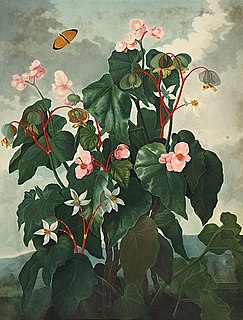
Begonia is a genus of perennial flowering plants in the family Begoniaceae. The genus contains more than 1,800 different plant species. The Begonias are native to moist subtropical and tropical climates. Some species are commonly grown indoors as ornamental houseplants in cooler climates. In cooler climates some species are cultivated outside in summertime for their bright colorful flowers, which have sepals but no petals.

Vernonia is a genus of about 350 species of forbs and shrubs in the family Asteraceae. Some species are known as ironweed. Some species are edible and of economic value. They are known for having intense purple flowers. The genus is named for the English botanist William Vernon. There have been numerous distinct subgenera and subsections named in this genus, and some botanists have divided the genus into several distinct genera. For instance, the Flora of North America recognizes only about twenty species in Vernoniasensu stricto, seventeen of which are in North America north of Mexico, with the others being found in South America.
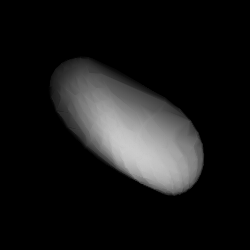
943 Begonia is a large, carbonaceous background asteroid, approximately 70 kilometers in diameter, from the outer region of the asteroid belt. It was discovered by German astronomer Karl Reinmuth at the Heidelberg Observatory on 20 October 1920 and given the provisional designations A920 UA and 1920 HX. The dark C-type asteroid (Ch) has a rotation period of 15.7 hours. It was named after the genus of popular houseplants, Begonia.
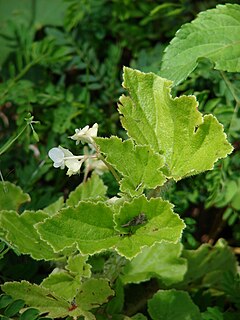
Begoniaceae is a family of flowering plants with two genera and about 1825 species occurring in the subtropics and tropics of both the New World and Old World. All but one of the species are in the genus Begonia. There have been many recent discoveries of species in the genus Begonia, such as Begonia truncatifolia which is endemic to San Vincente, Palawan. B. truncatifolia is smaller in size than other species of the genus Begonia and this new species is proposed Critically Endangered by standards set by the IUCN. The only other genus in the family, Hillebrandia, is endemic to the Hawaiian Islands and has a single species. Phylogenetic work supports Hillebrandia as the sister taxon to the rest of the family. The genus Symbegonia was reduced to a section of Begonia in 2003, as molecular phylogenies had shown it to be derived from within that genus. Members of the genus Begonia are well-known and popular houseplants.

The cane begonias are a group of Begonia cultivars. Their name derives from their tough, bamboo-like stems. They can grow up to 10 ft (3.0 m) tall, which may necessitate staking. They are often ideal as houseplants when kept under control.
Begonia eiromischa, commonly known as woolly-stalked begonia, is a presumed extinct plant from Malaysia.

Begonia grandis, the hardy begonia, is a species of flowering plant in the family Begoniaceae. This herbaceous perennial has alternate, simple leaves on arching stems. The flowers are pink or white, borne in dichotomously branching cymes from late summer through fall in USDA U.S. Hardiness Zone 7. As the common name "hardy begonia" implies, it is winter hardy in some temperate regions.

Duponchelia fovealis is a species of moth of the family Crambidae described by Philipp Christoph Zeller in 1847. It is endemic to the area surrounding the Mediterranean Sea, and the Canary Islands, but has extended its range to other parts of Africa, Europe, the Middle East and North America.

Begonia sutherlandii, known as the Sutherland begonia and as iwozya in Kimalila, Tanzania, is a tuberous flowering perennial plant in the family Begoniaceae, growing to 0.5 metres (20 in) with fleshy pink stems from 10 to 80 centimetres long. Leaves are commonly dark green and veined with red and covered with short hairs on the underside. They are asymmetrical in shape and the margin is toothed. Flowers, produced in pendent panicles throughout summer, are 20–26 millimetres (0.8–1.0 in) in diameter, and are usually orange or orange–red with yellow anthers.
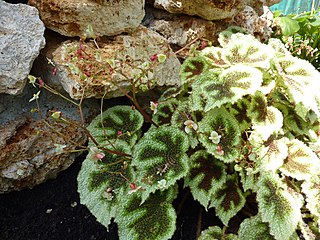
Begonia masoniana, the iron cross begonia, is a species of plant in the family Begoniaceae, native to southern China and northern Vietnam. It was originally described from cultivated plants of unknown origin and was only much later rediscovered in the wild. It is a rhizomatous perennial begonia growing to 0.5 metres (20 in), bearing large, asymmetrical, textured green leaves covered in reddish hairs, with a prominent dark brown pattern in the centre of each leaf, reminiscent of the German Iron Cross. It produces small white flowers in erect panicles, but is cultivated mainly for its foliage effect. In temperate regions it must be grown under glass, or in a completely frost-free environment. Although sometimes (incorrectly) considered a rex begonia, this species is classified in the related section Coelocentrum.
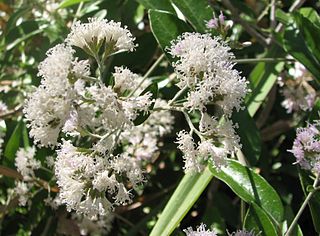
Tarlmounia is a plant genus in the family Asteraceae. The sole species is Tarlmounia elliptica, native to India, Burma and Thailand and naturalised in southern Taiwan and Queensland, Australia. Common names include curtain creeper, vernonia creeper and parda bel.
Begonia aenea is a species of is a species of plant in the family Begoniaceae. It is endemic to Assam.
Begonia tessaricarpa is a species of flowering plant in the family Begoniaceae. It is endemic to China.
Begonia thomeana is a species of is a species of plant in the family Begoniaceae. It is endemic to Cameroon and Gabon.
Begonia thomsonii is a species of plant in the family Begoniaceae. It is native to the East Himalaya region, northeast India, Bangladesh and Myanmar.
Begonia tiliifolia is a species of flowering plant in the family Begoniaceae. It is endemic to Colombia and Venezuela.
The Philippine Taxonomic Initiative (PTI) is a private Philippine research institute and non-profit organization located in Palawan.
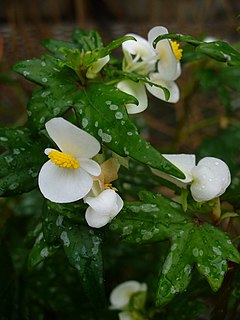
Begonia dregei, the maple leaf begonia or grape-leaf begonia, is a species of flowering plant in the genus Begonia native to South Africa. It has gained the Royal Horticultural Society's Award of Garden Merit.
Danilo Tandang is a Filipino botanist, working in the National Museum of the Philippines, Philippines











